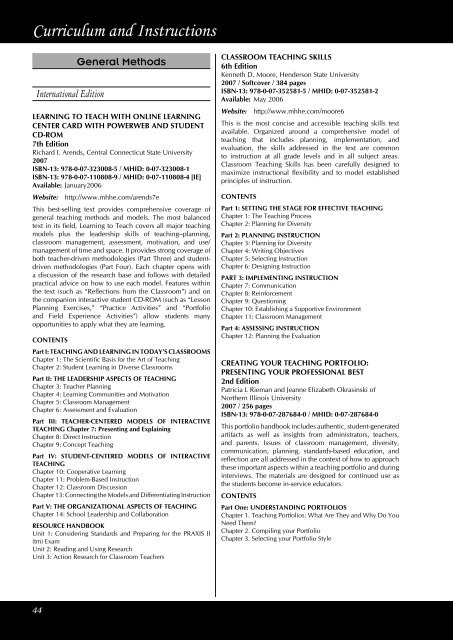table of contents - McGraw-Hill Books
table of contents - McGraw-Hill Books
table of contents - McGraw-Hill Books
Create successful ePaper yourself
Turn your PDF publications into a flip-book with our unique Google optimized e-Paper software.
Curriculum and Instructions<br />
International Edition<br />
General Methods<br />
LEARNING TO TEACH WITH ONLINE LEARNING<br />
CENTER CARD WITH POWERWEB AND STUDENT<br />
CD-ROM<br />
7th Edition<br />
Richard I. Arends, Central Connecticut State University<br />
2007<br />
ISBN-13: 978-0-07-323008-5 / MHID: 0-07-323008-1<br />
ISBN-13: 978-0-07-110808-9 / MHID: 0-07-110808-4 [IE]<br />
Available: January2006<br />
Website: http://www.mhhe.com/arends7e<br />
This best-selling text provides comprehensive coverage <strong>of</strong><br />
general teaching methods and models. The most balanced<br />
text in its field, Learning to Teach covers all major teaching<br />
models plus the leadership skills <strong>of</strong> teaching--planning,<br />
classroom management, assessment, motivation, and use/<br />
management <strong>of</strong> time and space. It provides strong coverage <strong>of</strong><br />
both teacher-driven methodologies (Part Three) and studentdriven<br />
methodologies (Part Four). Each chapter opens with<br />
a discussion <strong>of</strong> the research base and follows with detailed<br />
practical advice on how to use each model. Features within<br />
the text (such as “Reflections from the Classroom”) and on<br />
the companion interactive student CD-ROM (such as “Lesson<br />
Planning Exercises,” “Practice Activities” and “Portfolio<br />
and Field Experience Activities”) allow students many<br />
opportunities to apply what they are learning.<br />
CONTENTS<br />
Part I: TEACHING AND LEARNING IN TODAY’S CLASSROOMS<br />
Chapter 1: The Scientific Basis for the Art <strong>of</strong> Teaching<br />
Chapter 2: Student Learning in Diverse Classrooms<br />
Part II: THE LEADERSHIP ASPECTS OF TEACHING<br />
Chapter 3: Teacher Planning<br />
Chapter 4: Learning Communities and Motivation<br />
Chapter 5: Classroom Management<br />
Chapter 6: Assessment and Evaluation<br />
Part III: TEACHER-CENTERED MODELS OF INTERACTIVE<br />
TEACHING Chapter 7: Presenting and Explaining<br />
Chapter 8: Direct Instruction<br />
Chapter 9: Concept Teaching<br />
Part IV: STUDENT-CENTERED MODELS OF INTERACTIVE<br />
TEACHING<br />
Chapter 10: Cooperative Learning<br />
Chapter 11: Problem-Based Instruction<br />
Chapter 12: Classroom Discussion<br />
Chapter 13: Connecting the Models and Differentiating Instruction<br />
Part V: THE ORGANIZATIONAL ASPECTS OF TEACHING<br />
Chapter 14: School Leadership and Collaboration<br />
RESOURCE HANDBOOK<br />
Unit 1: Considering Standards and Preparing for the PRAXIS II<br />
(tm) Exam<br />
Unit 2: Reading and Using Research<br />
Unit 3: Action Research for Classroom Teachers<br />
CLASSROOM TEACHING SKILLS<br />
6th Edition<br />
Kenneth D. Moore, Henderson State University<br />
2007 / S<strong>of</strong>tcover / 384 pages<br />
ISBN-13: 978-0-07-352581-5 / MHID: 0-07-352581-2<br />
Available: May 2006<br />
Website: http://www.mhhe.com/moore6<br />
This is the most concise and accessible teaching skills text<br />
available. Organized around a comprehensive model <strong>of</strong><br />
teaching that includes planning, implementation, and<br />
evaluation, the skills addressed in the text are common<br />
to instruction at all grade levels and in all subject areas.<br />
Classroom Teaching Skills has been carefully designed to<br />
maximize instructional flexibility and to model established<br />
principles <strong>of</strong> instruction.<br />
CONTENTS<br />
Part 1: SETTING THE STAGE FOR EFFECTIVE TEACHING<br />
Chapter 1: The Teaching Process<br />
Chapter 2: Planning for Diversity<br />
Part 2: PLANNING INSTRUCTION<br />
Chapter 3: Planning for Diversity<br />
Chapter 4: Writing Objectives<br />
Chapter 5: Selecting Instruction<br />
Chapter 6: Designing Instruction<br />
PART 3: IMPLEMENTING INSTRUCTION<br />
Chapter 7: Communication<br />
Chapter 8: Reinforcement<br />
Chapter 9: Questioning<br />
Chapter 10: Establishing a Supportive Environment<br />
Chapter 11: Classroom Management<br />
Part 4: ASSESSING INSTRUCTION<br />
Chapter 12: Planning the Evaluation<br />
CREATING YOUR TEACHING PORTFOLIO:<br />
PRESENTING YOUR PROFESSIONAL BEST<br />
2nd Edition<br />
Patricia L Rieman and Jeanne Elizabeth Okrasinski <strong>of</strong><br />
Northern Illinois University<br />
2007 / 256 pages<br />
ISBN-13: 978-0-07-287684-0 / MHID: 0-07-287684-0<br />
This portfolio handbook includes authentic, student-generated<br />
artifacts as well as insights from administrators, teachers,<br />
and parents. Issues <strong>of</strong> classroom management, diversity,<br />
communication, planning, standards-based education, and<br />
reflection are all addressed in the context <strong>of</strong> how to approach<br />
these important aspects within a teaching portfolio and during<br />
interviews. The materials are designed for continued use as<br />
the students become in-service educators.<br />
CONTENTS<br />
Part One: UNDERSTANDING PORTFOLIOS<br />
Chapter 1. Teaching Portfolios: What Are They and Why Do You<br />
Need Them?<br />
Chapter 2. Compiling your Portfolio<br />
Chapter 3. Selecting your Portfolio Style<br />
44

















